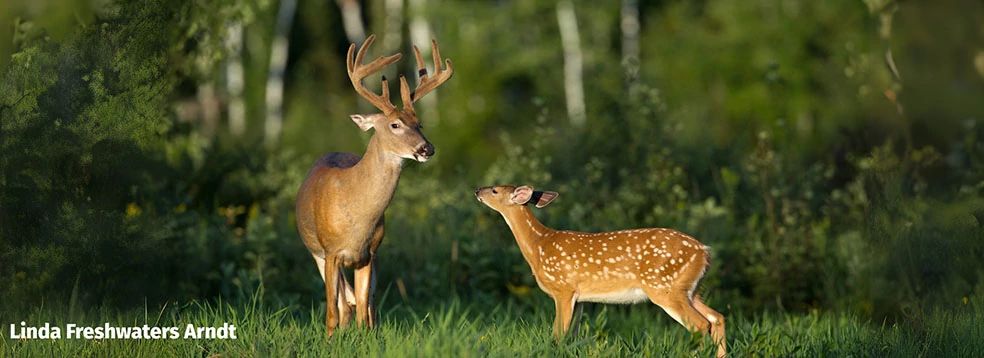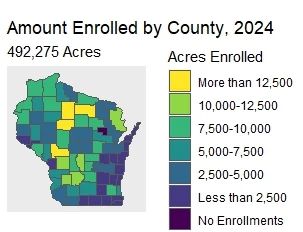Deer Management Assistance Program
"A partnership for healthy habitat and healthy deer"
DMAP will be open for enrollment again in early-mid 2026. If you would like to be alerted when DMAP enrollment opens, please fill out this form to provide us with your contact information. When enrollment is about to open, a notification will be sent out with further information on the DMAP registration process and who to contact with any questions.

The Wisconsin Deer Management Assistance Program (DMAP) is a collaborative initiative between the Wisconsin DNR, landowners and hunters aimed at enhancing wildlife habitat and managing deer herd populations. Through this partnership, wildlife professionals provide expert guidance, resources and tools to help members achieve their specific management objectives. In return, DMAP members contribute valuable deer harvest and observation data, which is essential for the informed management of Wisconsin’s deer herd. DMAP is open to all private landowners, land managers (public or private) or hunters, regardless of land size or management goals.
Why Become A Member?
Whether you have 5 acres or 500, DMAP has something to offer. DMAP members gain direct access to a local DMAP biologist, free participation in a variety of educational opportunities and use of MyDMAP, a personalized database. MyDMAP is designed to connect members with tools and resources to aid in achieving their management goals. For example, members can track habitat management projects, deer observations and harvests, which are then used to generate a customized annual Herd and Habitat Report. This report allows members to track their habitat management progress and deer harvest across time and compare it to local and state trends. Anyone interested in learning more about becoming a member should visit the membership FAQ section.
Elective Benefits
Any DMAP member with 40 acres or more is eligible to apply for additional services, known as elective benefits. These elective benefits are curated for each landowner and property and, as such, can change according to personal needs and goals. The full list of options includes a site visit, DMAP Project Plan, Property Recommendations Summary and DMAP antlerless tags (if eligible based on a Deer Impact Assessment). After their first site visit, members gain additional flexibility in customizing their DMAP elective benefits. Anyone interested in learning more about these benefits should visit the elective benefits FAQ section.
Associated Fees
Membership
$50 membership fee every three years.
Elective Benefits
- 40-160 acres
- First visit: $150 service fee
- Follow-up visit(s): $100 service fee
- 160-640 acres
- First visit: $200 service fee
- Follow-up visit(s): $125 service fee
- 640+ acres
- First visit: $250 service fee
- Follow-up visit(s): $150 service fee
DMAP Resources
DMAP members have access to a wide array of technical and educational resources. These include videos produced by DMAP biologists covering topics such as timber stand improvement, scientific articles on deer management and custom tracking tools, like the Herd and Habitat Report. The DMAP team produces a monthly e-newsletter, the Herd and Habitat Happenings, to keep members in the loop on all things deer and habitat management. Additionally, eligible members can opt in for elective benefits and receive a personalized Property Recommendations Summary and/or detailed DMAP Project Plan to help identify and implement priority management projects. See examples of DMAP resources, the Herd and Habitat Happenings newsletter, a DMAP Project Plan and a Property Recommendations Summary below.
Important Dates
Dec. 31: Members looking to apply for elective benefits must meet all eligibility requirements.
Jan. 1-Feb. 15: Elective benefits application is open.
April-May: Members who are selected to receive elective benefits are notified and have 30 days to pay their service fee and complete all required forms.
Annual Reports
DMAP's mission is to partner with private landowners and hunters to foster positive relationships, implement sound landowner-specific habitat and deer herd management, and collect data to support deer management in Wisconsin.
To learn more about how we work to achieve that mission, check out our annual reports:
DMAP In Wisconsin

One of the fundamental values of DMAP is that white-tailed deer are an important wildlife resource in Wisconsin and should be held in the public trust for the benefit of all people. With around 500,000 acres of land enrolled across 71 counties and growing, DMAP brings landowners and managers together to provide healthy habitat and healthy deer across property boundaries. The DMAP program is also dedicated to going beyond deer and helping interested parties manage their property for any wildlife species.
Frequently Asked Questions (FAQs)
General Membership
How do I become a DMAP member or renew my membership?
The only requirements for joining DMAP are creating a MyDMAP account and paying the membership fee; this needs to be completed by whoever will be the primary member. To create a MyDMAP account, you will need a My Wisconsin ID. Membership renewal is also completed by the primary member by logging into MyDMAP and following the prompts.
What types of DMAP members are there?
There are two types of members: primary and associate. The primary member is the account holder and is responsible for paying all fees, managing associate members, coordinating elective benefits and ensuring all requirements are met. Associate members are added by the primary member, giving them access to the property’s MyDMAP account. Associate members can also engage with all of the educational opportunities, but they do not have to pay a membership fee. There is no limit to the number of associate members a primary member can add to a property.
Every property is required to have a primary member, but the number of associate members a property can add is unlimited.
What if I own multiple properties?
Primary members are allowed to enroll as many properties as they want under their membership. Thus, one primary membership can cover multiple properties. However, elective benefit service fees are property-specific.
Can corporations, businesses, trusts or similar entities become DMAP members?
Yes, organizations can become members. However, they must complete documentation that identifies an authorized representative who can make decisions on behalf of the entity.
Can someone who manages a property that they do not personally own enroll that property in DMAP?
Yes, an individual who does not own a property can enroll a property they manage as an authorized representative. When enrolling the property, they will need to provide the name and contact information for all landowners with signature authority. If elective benefits are requested, these landowners would need to sign all appropriate documents and designate the primary member as an authorized representative before elective benefits can be provided.
Can landowners interested in managing habitats for wildlife other than deer join DMAP?
Yes! DMAP offers recommendations based on the landowner’s goals, whether they are deer-related (more deer, fewer deer, bigger bucks) or non-deer-focused (songbirds, grouse, turkey, native plants, etc.). DMAP biologists will provide recommendations for improving the habitat for the wildlife you’re interested in.
What is a DMAP group cooperative?
A DMAP group cooperative is an association of up to three adjoining individual property owners or their representatives who organize to manage deer and other wildlife resources and whose members have agreed to participate in DMAP.
Elective Benefits
What types of benefits can I receive?
The full list is as follows:
- Site Visit: An on-site visit with a DMAP Biologist to discuss goals, actions taken and identify priority projects. DNR foresters may also be involved, depending on the services requested and member needs.
- Property Recommendations Summary: A summary of the management recommendations discussed during the site visit.
- DMAP Project Plan: A step-by-step guide for implementing the priority habitat management projects identified during the site visit.
- Deer Impact Assessment: An evaluation of deer impacts on herd or habitat condition for individuals interested in DMAP’s bonus antlerless tags.
- DMAP Bonus Antlerless Tags: Half-price bonus tags for qualifying properties.
What is the deadline to receive elective benefits?
To receive elective benefits, a completed application must be submitted between Jan. 1 and Feb. 15.
Can everyone receive elective benefits?
Every property with an active membership that meets the acreage requirement is eligible to apply to receive elective benefits once. Members can elect to receive benefits again if it’s been at least 3 years since their last visit and they have met the reporting requirements for the service(s) they’re interested in receiving. Individuals interested in habitat-related services (site visit, property recommendations summary, project plan) will need to report on the habitat actions taken since their last visit. Those interested in tags will need to report deer harvest data annually and have a Deer Impact Assessment completed every three years.
How are caps on elective benefits determined?
Caps will be developed on regional basis annually based on staff capacity. If caps are instituted, private landowners will receive services prior to public lands.
What can I expect during my first site visit?
During your first site visit, a biologist and forester will tour your property to discuss any concerns and goals, answer any questions you may have, and work collaboratively with you to identify the best projects to you achieve your goals. To accomplish this, we ask landowners to identify spots or areas of interest for us to visit while on the property. The amount of time, projects and spots you can expect based on acreage are as follows:
- 40-160
- 2-3 hours
- 2-3 projects
- 3-5 spots
- 160-640
- 3-4 hours
- 2-4 projects
- 4-6 spots
- 640+
- 4-6 hours
- 2-5 projects
- 5-8 spots
These estimates are general, as site visits will be designed to fit your needs. Some may take longer or have fewer designated spots.
- 40-160
What do I get after my first site visit?
After your first site visit, your local DMAP biologist will provide a Property Recommendations Summary outlining the topics covered during the visit. Its main purpose is to give a short summary highlighting what was discussed on the site visit. This will be followed up with a DMAP Project Plan that provides detailed directions on implementing the priority projects identified during the visit.
Antlerless Tags
What is the DMAP bonus antlerless tag program?
DMAP’s antlerless tag program provides half-price antlerless tags to qualifying members to address herd or habitat health concerns resulting from an overabundance of deer. Thus, they are designed to serve as a tool in helping achieve management goals.
How will the department determine if DMAP bonus antlerless tags should be issued to members?
Qualification for DMAP bonus antlerless tags is determined by DNR staff during a site visit through a Deer Impact Assessment. The assessment used will include an evaluation of deer harvest history, local deer numbers and property goals, as well as a herd or habitat health assessment depending on the landowner’s concerns.
What are the eligibility requirements?
Private lands are eligible to receive tags as long as they qualify for elective benefits, receive a Deer Impact Assessment every three years that indicates tag need, and submit deer harvest data annually.
Can landowners sell DMAP bonus antlerless tags to other hunters?
Yes. Landowners or representatives can sell them for no more than the original cost. DMAP antlerless tags may only be used on the DMAP property for which they were issued.
Miscellaneous
Who can participate in DMAP workshops?
All DMAP members, primary or associate, are encouraged to attend DMAP workshops and bring along interested family members, neighbors and friends. Workshops present information on deer and habitat management and offer an opportunity to network with other members and natural resources professionals. Topics vary by workshop but may include deer herd health, deer management strategies, wildlife biology, forest and habitat management, funding sources and much more. Workshops are typically a mix of talks from guest speakers, hands-on activities and field trips. Additionally, DMAP offers virtual workshops on a variety of research, ecology and management topics.
How will properties that are enrolled in the Managed Forest Law (MFL) or Forest Crop Law (FCL) program work within DMAP?
Properties enrolled in MFL or FCL may participate in DMAP and receive elective benefits. If a DMAP Project Plan is requested, it will provide additional management options for wildlife habitat and is intended to complement recommendations provided in the MFL or FCL plan.
For DMAP, are properties enrolled in the Managed Forest Law program considered private or public lands?
Currently, properties enrolled in the MFL program (open or closed) are considered private properties. As such, MFL properties enrolled in DMAP are eligible for private land benefits, including management recommendations.
How will DMAP be applied to public lands?
Public land managers with an interest in DMAP are welcome to join, but priority for elective benefits is given to private lands in years where caps are implemented. In some cases, not all qualifying individuals requesting service in any given year will receive it, in which case, waitlists may be established.
